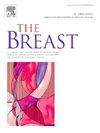Safety and efficacy of combined trastuzumab-deruxtecan and concurrent radiation therapy in breast cancer. The TENDANCE multicentric French study
IF 5.7
2区 医学
Q1 OBSTETRICS & GYNECOLOGY
引用次数: 0
Abstract
Purpose
Trastuzumab Deruxtecan (T DXD), a new antibody drug conjugate is a new treatment option for 2nd line metastatic breast cancer (MBC) for HER2 + or HER2 low tumors. Palliative or ablative radiotherapy (RT) may be required in patients who are being treated with T-DXd. However there is a lack of evidence regarding the safety profile of combining T-DXd with RT. TENDANCE study aimed to evaluate safety and efficacy of combined T-DXd and RT.
Materials and methods
This retrospective multicenter study included 54 patients treated concurrently with T-DXd and RT for HER2+ and HER2 low MBC between February 2021 and December 2023. All data were collected from a web-questionnaire, centralized after medical records and validation of the protocol by the local ethical committee. Primary endpoint was the safety of combined therapy.
Results
Median age was 60 years. Patients who received T-DXD were further categorized into HER2+ (40.7 %), HER2 low/hormonal receptors HR+ (40.8 %) or HER2 low/HR- (18.5 %). In the HER2+ patients, T-DXd was administered as 2nd (18.2 %) or 3rd (31.8 %) or 4th (50 %) line therapy. RT was delivered using palliative (72.2 %) or ablative doses (27.8 %). Indications consisted mostly of palliative bone irradiation (46.3 %) and stereotactic radiosurgery (SRS) (25.9 %). With the median follow-up of 9 months, 22.2 % of patients had a complete response and 77.8 % had either a partial response or stable disease. Grade 1 or 2 asthenia was observed in 51.8 % of patients, while only 16.6 % experienced other grade 1 or 2 adverse effects. There was no T-DXd therapy discontinuation related to RT.
Conclusion
To our knowledge, TENDANCE is the largest study evaluating concurrent T-DXd and RT. This preliminary report suggests the feasibility of the combination of RT and T-DXd with manageable toxicity rate. Longer follow-up and further prospective studies are required to confirm these results.
曲妥珠单抗-德鲁德康联合放射治疗乳腺癌的安全性和有效性。TENDANCE多中心法语研究
目的:trastuzumab Deruxtecan (T DXD)是一种新的抗体药物偶联物,是治疗二线转移性乳腺癌(MBC) HER2 +或HER2低肿瘤的新选择。接受T-DXd治疗的患者可能需要姑息或消融放疗(RT)。然而,关于T-DXd联合RT的安全性缺乏证据。TENDANCE研究旨在评估T-DXd和RT联合治疗的安全性和有效性。材料和方法这项回顾性多中心研究纳入了54例在2021年2月至2023年12月期间同时接受T-DXd和RT治疗的HER2+和HER2低MBC患者。所有数据均通过网络问卷收集,在病历记录和当地伦理委员会对方案进行验证后集中收集。主要终点是联合治疗的安全性。结果中位年龄为60岁。接受T-DXD的患者进一步分为HER2+(40.7%)、HER2低/激素受体HR+(40.8%)或HER2低/HR-(18.5%)。在HER2+患者中,T-DXd作为第2线(18.2%)、第3线(31.8%)或第4线(50%)治疗。放疗采用姑息治疗(72.2%)或消融治疗(27.8%)。适应症主要包括姑息性骨照射(46.3%)和立体定向放射外科(25.9%)。中位随访时间为9个月,22.2%的患者完全缓解,77.8%的患者部分缓解或病情稳定。51.8%的患者出现1级或2级虚弱,而只有16.6%的患者出现其他1级或2级不良反应。结论TENDANCE是目前最大的评估T-DXd和RT同时使用的研究。初步报告表明,RT和T-DXd联合使用的可行性,毒副率可控。需要更长的随访和进一步的前瞻性研究来证实这些结果。
本文章由计算机程序翻译,如有差异,请以英文原文为准。
求助全文
约1分钟内获得全文
求助全文
来源期刊

Breast
医学-妇产科学
CiteScore
8.70
自引率
2.60%
发文量
165
审稿时长
59 days
期刊介绍:
The Breast is an international, multidisciplinary journal for researchers and clinicians, which focuses on translational and clinical research for the advancement of breast cancer prevention, diagnosis and treatment of all stages.
 求助内容:
求助内容: 应助结果提醒方式:
应助结果提醒方式:


